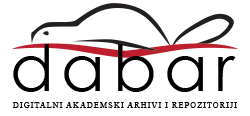Title Likovno darovita djeca Title (english) Artistically gifted children Author Nina Cibula Mentor Marijana Županić Benić (mentor)Committee member Antonija Balić (predsjednik povjerenstva)Committee member Morana Varović Čekolj (član povjerenstva) Committee member Marijana Županić Benić (član povjerenstva)Granter University of Zagreb Defense date and country 2024-09-16, Croatia Scientific / art field, SOCIAL SCIENCES Scientific / art field, FIELD OF ART Abstract Ovaj je rad usmjeren na sažet prikaz definiranja pojma darovitost te karakteristika koje obilježavaju, odnosno isti u darovito dijete rane i predškolske dobi u odnosu na njegove vršnjake. Usprkos postojanju sredstava za prepoznavanje i identifikaciju poput raznih ljestvica procjena, kontrolnih lista za identifikaciju darovitosti te standardiziranih testova i ostalih metoda, darovita djeca se nalaze u ranjivoj poziciji radi teškoća pri identifikaciji. Do navedenog problema najčešće dolazi zbog nedovoljne educiranosti sudionika odgojno-obrazovnog procesa. Stoga se u radu navodi i kroz primjere odgovarajućeg djelovanja opisuje iznimna
važnosti da odgojitelji, roditelji te ostali sudionici teže stvaranju i osiguravanju primjerene i poticajne djetetove okoline unutar koje će se provoditi pažljivo osmišljen odgojno-obrazovni rad primjeren individualnim potrebama svakog darovitog djeteta. Nadalje, u radu se razrađuje područno-specifična darovitost koja se u radu navodi pod nazivom likovna darovitost. Likovna darovitost znatno je manje istražena u odnosu na opću darovitost, stoga je ljudsko znanje o navedenoj darovitosti i dalje ograničeno, kao i dostupni programi za razvijanje likovne darovitosti. Također, u radu se navodi lista sa specifičnim znakovima koji su često primijećeni u ponašanju likovno darovite djece te opisuju likovne sposobnosti koje karakteriziraju znakovi odnose na vanjske oblike ponašanja i vidljive djetetove karakteristike te da se svakom potencijalno likovno darovitom djetetu treba pristupiti individualno te kontinuirano pratiti tijek razvoja njegove likovne darovitosti. Sukladno navedenom, rad s likovno darovitom djecom zahtjeva posebno osmišljene programe rada koji će djelovati optimalno na razvoj i unaprjeđenje sposobnosti darovite djece. U radu se navode mogućnosti poput obogaćenja osnovnog programa dodatnim sadržajima te stvaranje kompleksnijeg programa. Međutim, osim primjerenih programa rada, odgojiteljevo stru no znanje i potpora su ključni kako bi se likovno darovito dijete osjetilo uvaženo i sigurno pri stvaranju svojih djela. Posljednje, u radu se navode faktori likovne kreativnosti koji služe kao orijentir za identifikaciju i razvoj kreativnosti. Na temelju navedenih faktora, u radu se prikazuje slučaj analize likovnih radova potencijalno likovno darovitog dječaka.
Abstract (english) This paper is focused on a concise presentation of the definition of the term giftedness and the characteristics that mark or emphasize a gifted child of early and preschool age in relation to his peers. Despite the existence of tools for recognition and identification such as various assessment scales, giftedness identification checklists and standardized tests and other methods, gifted children are in a vulnerable position due to difficulties in identification. The mentioned problem most often occurs due to insufficient education of the participants in the educational process. Therefore, the paper states and describes through examples of appropriate action the exceptional importance that educators, parents and other participants strive to create and ensure an appropriate and stimulating environment for the child. Within which carefully designed educational work appropriate to the individual needs of each gifted child will be carried out. Furthermore, the paper elaborates on area-specific giftedness, which is referred to in the paper as artistic giftedness. Artistic giftedness has been much less researched than general giftedness, therefore human knowledge about said giftedness is still limited, as well as available programs for developing artistic giftedness. Also, the paper provides a list of specific signs that are often observed in the behavior of artistically gifted children and describes the artistic abilities that characterize the uniqueness of their artistic creativity. Although, it is necessary to take into account that the mentioned signs refer to the external forms of behavior and visible characteristics of the child, and that each potentially artistically gifted child should be approached individually and continuously monitor the course of development of his artistic giftedness. In accordance with the above, working with artistically gifted children requires specially designed work programs that will have an optimal effect on the development and improvement of the abilities of gifted children. The paper mentions possibilities such as enriching the basic program with additional content and creating a more complex program. However, in addition to appropriate work programs, the educator's professional knowledge and support are crucial in order for a gifted child to feel respected and safe when creating his works. Finally, the paper lists the factors of artistic creativity that serve as a landmark for the identification and development of creativity. Based on the aforementioned factors, the paper presents the case of the analysis of art works of a potentially artistically gifted boy.
Keywords
likovna darovitost
dijete
identifikacija
Keywords (english)
artistic giftedness
child
identification
Language croatian URN:NBN urn:nbn:hr:147:109459 Study programme Title: Graduate University Study of Early and Preschool Education Type of resource Text File origin Born digital Access conditions Open access Terms of use Created on 2025-01-16 12:33:52

